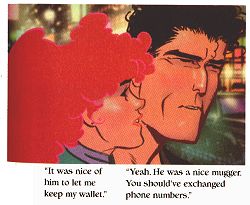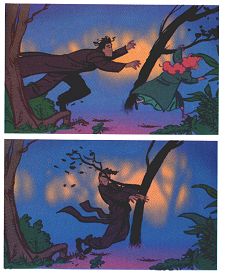You Are Here

![]() Kyle Baker is a minor legend among many comics fans. Some of this is due to Why I Hate Saturn, a comicbook seemingly designed to appeal to people who don’t like comicbooks (but do like books that are comic), the rest is for the legendary greatness of The Cowboy Wally Show, a comedic graphic novel that for many years was nearly impossible to find (and subsequently all the more revered).
Kyle Baker is a minor legend among many comics fans. Some of this is due to Why I Hate Saturn, a comicbook seemingly designed to appeal to people who don’t like comicbooks (but do like books that are comic), the rest is for the legendary greatness of The Cowboy Wally Show, a comedic graphic novel that for many years was nearly impossible to find (and subsequently all the more revered).
So You Are Here has a big rep to live up to.
On the whole, I think it succeeds.
It’s the story of Noel Coleman, a former denizen of the New York City criminal underworld, and Helen Foster, a cheerfully new-age inhabitant of rural upstate New York, Noel’s year-long girlfriend. He’s ready to go straight and leave his ugly past behind to stay with her. She’s blissfully ignorant of who he “really” is. Then when Noel goes to the city to tie off some loose ends there, she surprises him and follows. You can imagine the comedy of errors that will ensue. Or at least you think you can. But Baker will surprise you.
 There are some amusing scenes that play off Helen’s innocent naiveté, of course, but not simply at her expense. She’s resourceful and surprisingly effective, even out of her element. Likewise, cynical Noel is often the butt of the joke, yet he also remains two-dimensional. (No, not “three-dimensional”; I reserve that for characters who convince me that they’re real. And this is still “just” a farce.) Of course, being neither a babe from the woods, nor a streetwise thug, I can laugh equally at both of them. {smile}
There are some amusing scenes that play off Helen’s innocent naiveté, of course, but not simply at her expense. She’s resourceful and surprisingly effective, even out of her element. Likewise, cynical Noel is often the butt of the joke, yet he also remains two-dimensional. (No, not “three-dimensional”; I reserve that for characters who convince me that they’re real. And this is still “just” a farce.) Of course, being neither a babe from the woods, nor a streetwise thug, I can laugh equally at both of them. {smile}
By the same token, the story is more than just a bunch of laugh-out-loud jokes. Even when the action is played for laughs (or at least smirks), there’s an undercurrent of real violence and danger that surfaces from time to time, sometimes when least expected. It may be funny, but it’s not simply lighthearted fare for the kiddies. This is humour for grown-ups. (And by that I don’t mean that it’s full of “mature readers” bathroom humour. I said “grown-ups”, not “adolescents over the age of 18″.) And as long as I’m flirting with “advisory” mode, I should note that there’s some story-related nudity and sexual content.
Baker uses the same basic format for You Are Here that he used for Saturn: instead of superimposing word balloons and caption boxes over the pictures, he puts all of the text below each (borderless) panel, with the position of the words indicating who is speaking. (One addition, because You Are Here is in color, is that he sometimes colors the text, to distinguish narration from dialog, for example.) This is the approach has “tricked” some people into believing that they were not reading “comics”, because there were no “silly” word balloons (as well as no heroes in spandex). It also makes sense when working with art that tends toward photo-realism, because flat white word balloons start to look increasingly out of place as the art gets more “real”.
Baker’s use of digital media for the art is noteworthy. Computer-assisted coloring and lettering are nothing new in comics, of course, but very few artists are using it (yet) for anything beyond that. And when they do, the result is art that seems to address the viewer with each panel, saying “Excuse me, but have you noticed that I was created with a computer?” Which is distracting.
 You Are Here is not entirely immune from this problem. The opening pages feature a series of wonderfully cinematic sequences, that are spoiled a bit by geometric perfection and seamless rendering that only a computer can accomplish. Baker tries to compensate with some selective blurring and/or fading of foreground and background images and other tricks, but the images still end up difficult to read. Because everything is so perfect, nothing stands out, and the art just looks cluttered and busy. Nice as a technology demonstration; indifferent as art.
You Are Here is not entirely immune from this problem. The opening pages feature a series of wonderfully cinematic sequences, that are spoiled a bit by geometric perfection and seamless rendering that only a computer can accomplish. Baker tries to compensate with some selective blurring and/or fading of foreground and background images and other tricks, but the images still end up difficult to read. Because everything is so perfect, nothing stands out, and the art just looks cluttered and busy. Nice as a technology demonstration; indifferent as art.
Fortunately Baker doesn’t use this approach too heavily, and the art improves dramatically when he simply draws freehand in (invisibly tiny) pixels, rather than giving the computer mathematical 3D models to render. And all of the people and other critters, and much of the scenery are hand-drawn, using a digital stylus, I assume. So the figures don’t suffer at all from the stiffness and artificiality that plagued The Dome (recently published by Helix). In fact, they’re wonderfully fluid, demonstrating Baker’s fluency with facial and body language.
 Baker’s technique of text under the pictures could tempt the artist into doing lots of “talking heads” panels, but that rarely happens here. In fact, there are some action scenes and slapstick sequences that are done with exquisite frame-to-frame continuity and timing.
Baker’s technique of text under the pictures could tempt the artist into doing lots of “talking heads” panels, but that rarely happens here. In fact, there are some action scenes and slapstick sequences that are done with exquisite frame-to-frame continuity and timing.
But even with the hand-drawn figures, Baker still takes advantage of the digital medium he’s working with. For example, he sets the color of the “ink” used for outlining to complement the interior coloring. For example, Noel’s peach-colored face is outlined in matching brown, rather than black, and Helen’s red hair is outlined in pink to represent highlights. Not only does this allow for some subtler modeling, but it also helps the freehand and computer-rendered elements coexist in the same picture. Dropping flat figures with black outlining into a computer-rendered scene that has no outlines (like Scott McCloud did in The New Adventures of Abraham Lincoln) looks incongruous; Baker’s approach does less so.
Of course all of this nice art would be pointless if it were the only or primary point to the book. Books that “push the envelope” with new techniques and experimental technology can be fascinating to look at and pick apart. But most of us prefer to spend our money on entertainment. Which is why I’m pleased to report that You Are Here definitely delivers on that score. While some of Baker’s media experimentation in this book doesn’t quite work in spots, it doesn’t get in the way of enjoying the story and characters, which - as in his legendary earlier works - are the real focus.
You Are Here is a humourous but thoughtful tale about people, who they are and how they relate to each other. They’re a bit broadly drawn (both literally and figuratively), but real enough for comedy… and for a little bit more. And by the end, I think you’ll even be concerned about what happens to them.
